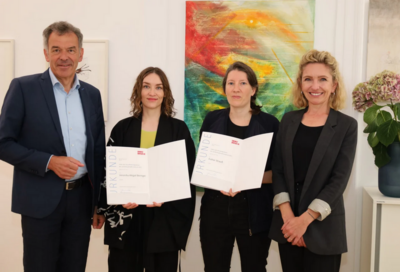Welcome at the Interface Culture program website.
Acting as creative artists and researchers, students learn how to advance the state of the art of current interface technologies and applications. Through interdisciplinary research and team work, they also develop new aspects of interface design including its cultural and social applications. The themes elaborated under the Master's programme in relation to interactive technologies include Interactive Environments, Interactive Art, Ubiquitous Computing, game design, VR and MR environments, Sound Art, Media Art, Web-Art, Software Art, HCI research and interaction design.

The Interface Culture program at the Linz University of Arts Department of Media was founded in 2004 by Christa Sommerer and Laurent Mignonneau. The program teaches students of human-machine interaction to develop innovative interfaces that harness new interface technologies at the confluence of art, research, application and design, and to investigate the cultural and social possibilities of implementing them.
The term "interface" is omnipresent nowadays. Basically, it describes an intersection or linkage between different computer systems that makes use of hardware components and software programs to enable the exchange and transmission of digital information via communications protocols.
However, an interface also describes the hook-up between human and machine, whereby the human qua user undertakes interaction as a means of operating and influencing the software and hardware components of a digital system. An interface thus enables human beings to communicate with digital technologies as well as to generate, receive and exchange data. Examples of interfaces in very widespread use are the mouse-keyboard interface and graphical user interfaces (i.e. desktop metaphors). In recent years, though, we have witnessed rapid developments in the direction of more intuitive and more seamless interface designs; the fields of research that have emerged include ubiquitous computing, intelligent environments, tangible user interfaces, auditory interfaces, VR-based and MR-based interaction, multi-modal interaction (camera-based interaction, voice-driven interaction, gesture-based interaction), robotic interfaces, natural interfaces and artistic and metaphoric interfaces.
Artists in the field of interactive art have been conducting research on human-machine interaction for a number of years now. By means of artistic, intuitive, conceptual, social and critical forms of interaction design, they have shown how digital processes can become essential elements of the artistic process.
Ars Electronica and in particular the Prix Ars Electronica's Interactive Art category launched in 1991 has had a powerful impact on this dialog and played an active role in promoting ongoing development in this field of research.
The Interface Cultures program is based upon this know-how. It is an artistic-scientific course of study to give budding media artists and media theoreticians solid training in creative and innovative interface design. Artistic design in these areas includes interactive art, netart, software art, robotic art, soundart, noiseart, games & storytelling and mobile art, as well as new hybrid fields like genetic art, bioart, spaceart and nanoart.
It is precisely this combination of technical know-how, interdisciplinary research and a creative artistic-scientific approach to a task that makes it possible to develop new, creative interfaces that engender progressive and innovative artistic-creative applications for media art, media design, media research and communication.
Hilde Zach Stipendium 2025
Esther Strauß erhält das Hilde Zach Stipendium 2025 der Stadt Innsbruck.
Herzliche Gratulation!
Am 23. September wurden die „Hilde-Zach-Kunststipendien 2025“ durch Vizebürgermeister Georg Willi an zwei Tiroler Künstlerinnen vergeben. Das Hauptstipendium in Höhe von 7.500 Euro geht heuer an die Performance- und Sprachkünstlerin Esther Strauß.
Das Förderstipendium in Höhe von 3.500 Euro nahm Veronika Abigail Beringer entgegen.
Aus 31 Einreichungen wählte die Fachjury, bestehend aus Sarah Jonas (Kuratorin/Sammlungsleitung Grafik und Fotografie im Lentos Museum, Linz), Gregor Sailer (Künstler) sowie Lena Ganahl (Leiterin Klocker Museum, Hall i. T.) die beiden Positionen.
„Ich freue mich, mit Esther Strauß und Veronika Abigail Beringer zwei Künstlerinnen auszuzeichnen und auf ihrer Laufbahn zu begleiten, die in Innsbruck, im öffentlichen Raum oder in Ausstellungen, bereits zahlreiche künstlerische Spuren hinterlassen haben“, gratuliert Vizebürgermeister Georg Willi: „Esther Strauß hat bereits 2016 das Förderstipendium erhalten – sie scheut sich nicht, relevante gesellschaftliche Themen wie Leben und Tod, Schuld und Verantwortung in ihrem Schaffen zu thematisieren. Werke der Künstlerin Veronika Beringer waren in der ‚Plattform 6020‘ zu sehen und sind inzwischen Teil der städtischen Kunstankäufe.“
Esther Strauß (geb. 1986) lebt und forscht in Wien, Linz und London. 2005 bis 2011 Studium an den Kunstuniversitäten Linz und Bristol, Abschluss mit Diplomen in Performance und Kulturwissenschaften. Seither Performances, Ausstellungen und Labore unter anderem im Sigmund Freud Museum London, Perdu Amsterdam, Fabbrica del Vapore Mailand, OK Linz, Künstlerhaus Wien, TAXISPALAIS Innsbruck.
Seit 2015 lehrt Strauß Sprachkunst an der Kunstuniversität Linz.
estherstrauss.info
www.ibkinfo.at/kunststipendien-strauss-beringer
